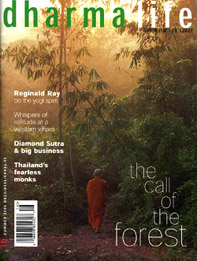Indestructible Truth
Reginald Ray
Shambhala, 2000
$29.95/£25 h/b
Reginald Ray, a senior teacher in the lineage of Trungpa Rimpoche, is Professor of Buddhist Studies at Naropa University whose last book was the acclaimed Buddhist Saints in India. His new book sets out to introduce Tibetan Buddhism, meaning the general Buddhism that was inherited by Tibetan Buddhism from India rather than tantric Buddhism in particular. He wants to 'strike a balance between a western scholar writing about Tibetan Buddhism and Tibetans speaking about their tradition in their own voices'.
He starts with Tibetan Buddhist views of the cosmos (which were actually carried over from medieval Indian Buddhism) which has Mount Meru at the centre, and features realms of gods, titans, humans, animals, ghosts and hells, manifestations of the Buddhas ... right down to local spirits of land or water. This is a lot for westerners to take on, so Ray supports it with voices from the Tibetan tradition. For instance, we hear of an American with an undiagnosable illness stumbling upon a Tibetan healer who enquired if he had worked on any streams. As it happened the man had moved rocks from a stream on his property. The healer told him to move them back as he had offended the local water spirit; he did so and his illness was cured!
Maybe so, but to a sceptical mind the story is as hard to swallow as the ideas it tries to prove. Sometimes westerners resist anything that can't be proved; sometimes they react the other way, naively accepting a world of ghosts and ghouls. Is either healthy or truly Buddhist? We need openly to explore these things, not be forced into a cleft stick of acceptance or rejection. Here, Ray the scholar has given way too easily to the confident voices of tradition.
Next come several chapters on Tibetan Buddhist history. They cover the transmission of Buddhism from India to Tibet and the creation of the schools of Tibetan Buddhism, with short biographies of the teachers who were responsible for this flowering of Buddhism. The founders' lives are given in enough detail to be enjoyable and often inspiring, but their subsequent lineages seem like a long list of names. This appears to be aimed not at the general reader, for whom it is surely too detailed, but at adherents to the Tibetan Buddhist tradition who want to know their relationship with their own history.
Then come the core teachings of the Hinayana and Mahayana (but not the Vajrayana, which is dealt with in a companion volume). This includes a skilful clarification of the relative nature of these terms, which are both a classification of the various historical schools and a way of naming stages on the individual's spiritual path. Such general Buddhist teachings as the Four Noble Truths, karma and rebirth, going for Refuge, the ethical precepts, shamatha and vipashyana meditation, the Bodhisattva vow and the six paramitas are all dealt with, but one would like greater acknowledgement that these are common Buddhist practices. Ray says, 'A practice done by many Tibetan Buddhists ... is that of the four immeasurables', but he does not point out that this is also true of other Buddhist traditions. This is not Tibetan Buddhist practice, just a Buddhist one.
The last section on Buddhist philosophy is necessarily closely argued and all the better for that. It explains the five skhandas or constituents of the person and the twelve nidanas or causal links very well (though this, too, is basic Buddhism, not just Tibetan Buddhism). The Madhyamaka and Buddha-nature philosophies of the Mahayana are treated even more fully, this time with the use of an exegetical tradition that arose in India but clearly developed further in Tibet.
He presents these aspects of Buddhist philosophy as three turnings of the Dharma, successive teachings the Buddha gave during his lifetime. This is the view of Tibetan Buddhist tradition, but it won't stand up to modern textual scholarship, which understands that not all these texts were the word of the historical Buddha - though all could be products of Enlightened minds. Ray must surely know this, but it is ignored. He says, 'The Buddha turned the wheel of the Dharma for a third and final time shortly before his death,' as if it were fact. Again the scholar has given way to the voices of tradition, much to the reader's loss.
Reginald Ray's Buddhist Saints in India was scholarly and critical in the best sense. But Indestructible Truth presents Tibetan Buddhism in its own terms, ignoring what we know from western scholarship. This is a manual for adherents of Tibetan Buddhism, rather than others interested in Buddhism. I wonder if in looking at one's adopted tradition, one looks over one's shoulder for approval, at the cost of the freedom to think creatively.
Kulamitra is Chairman of the North London Buddhist Centre



